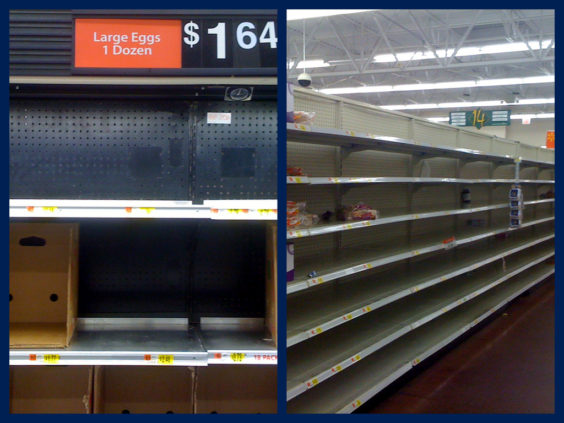
As any competitor will gladly tell you, Walmart’s lower prices come at a cost. Yes, you can get low prices on the things you need, but can you find an employee when you need help? Can you pay for your purchase without having to stand in a long line? And can you even find any of what you came to buy in the first place?
Bloomberg has hammered away at Walmart’s out-of-stock problems in recent years with articles like “Wal-Mart Struggles to Restock Store Shelves as U.S. Sales Slump” and “Wal-Mart Brings in Consultants to Help Keep Its Shelves Stocked”. And it’s at it again today, with a story entitled “Customers Flee Wal-Mart Empty Shelves for Target, Costco”. In the article, Walmart customers and employees share their tales of woe about Walmart’s often empty shelves.
“The number-one reason we gave up on Walmart was its prolonged, horrible, maddening inability to keep items in stock,” said one shopper. “Customers come in, they can’t find what they’re looking for, and they’re leaving,” said a Walmart employee. Shoppers are fleeing for other stores, annoyed by “how much time they wasted looking for items that aren’t there,” said a retail researcher.
Anyone who’s ever shopped at a Walmart – and that would probably be most everyone – has probably had an experience where something they wanted wasn’t on the shelf. And anecdotally, the conventional wisdom among shoppers is that yes, Walmart is better known for its low prices than its customer service, speedy checkout or ease of using coupons. But are Walmart shoppers really “fleeing for Target and Costco?” Aren’t they just as bad about having the occasional, frustratingly empty shelf?
Confirming that no issue has ever been left unstudied, there is in fact a study about this very issue. “Retail Out of Stocks”, conducted for the Grocery Manufacturers of America in 2002, found that the average out of stock rate among retailers is about 8%. Granted, the study is 11 years old, but it notes that the 8% figure has remained fairly constant, and “may simply be the ‘natural’ average for retailers engaged in the sales of fast moving packaged consumer goods.”
8% may not sound like too much, but if there are 25 items on your shopping list, it means you won’t be able to find two of them. And anything less than a 100% success rate in finding what you’re looking for, is guaranteed to be annoying. Retailers hope we’ll just substitute something similar, but the study found that the majority of us don’t – 28% of us give up and just cross the item off our list, and 32% buy what we want at another store instead.
Given how many items Walmart stocks, as compared to a typical grocery store, an 8% out-of-stock rate might just look worse than it really is. “Our in stock levels are up significantly in the last few years,” a Walmart spokesperson told Bloomberg, “so the premise of this story, which is based on the comments of a handful of people, is inaccurate and not representative of what is happening in our stores across the country.”
Yet that anecdotal evidence is hard to ignore, and it elicits knowing nods among many who’ve been there and seen that. The cosmetics section “looked like someone raided it,” one disappointed Walmart shopper told Bloomberg.
But, just as that 8% average out-of-stock figure hasn’t budged in decades, maybe Walmart has always been this way and we’re just now noticing, or complaining about it. When the economy was better and people were shopping at Walmart because they wanted to, not because they had to, the stores’ “lack of excellence was okay,” a retail researcher said. “You just don’t see that so much anymore.”










